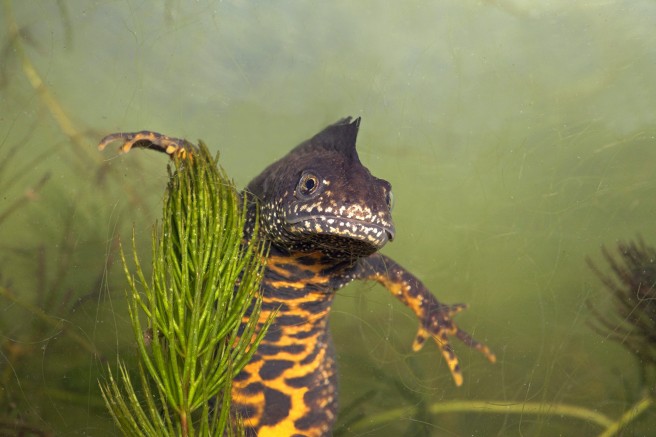Scientists from Freshwater Habitats Trust, SPYGEN, University of Kent, ARC and Natural England have recently published their findings concerning the use of eDNA to develop a national citizen science-based monitoring programme for the Great crested newt.
Follow our blog ! Subscribe to our RSS flux“Using eDNA to develop a national citizen science-based monitoring programme for the great crested newt (Triturus cristatus)”. This study by Biggs et al., published in the “Biological Conservation” journal in March 2015, first aimed to assess the effectiveness of eDNA methods for monitoring Great crested newts in the UK, compared with conventional techniques used for this species. Secondly, the study investigated the ability of volunteers to collect DNA samples in order to develop surveillance schemesat national scale.
The Great crested newt: a protected amphibian species in Europe
The Great crested newt (or Northern crested newt; Triturus cristatus) is a newt in the family Salamandridae, found across Europe and parts of Asia. Since the 1940s, populations of this species have declined in most of Europe due to changes in farming practices and loss of habitat. It is now a European Protected Species and corresponds to Britain’s most strictly protected amphibian. The conservation of this species requires that ponds surrounded by good quality terrestrial habitat are restored, and new ones are created. For this purpose, the species needs to be surveyed in a reliable way.
Performance of the DNA-based methods in comparison with traditional field methods
Using conventional field methods, substantial survey efforts are required to assess whether newts are absent from a site. The survey effort required to collect adequate data has until today prevented the establishment of a robust national programme for this species in the UK. In this study, the eDNA approach was compared with 3 main methods recommended in the UK for detecting the presence of the Great crested newt, namely night-time torch counting, overnight bottle trapping of adults and a visual egg search.
In 35 ponds visited four times through the breeding season, the eDNA approach enabled newts to be detected on 139 out of 140 visits (99.3% detection rate). Bottle traps, torch counts and egg searches were significantly less effective, detecting newts 76%, 75% and 44% of the time respectively. There were no false positives (detection of the species when it is not present) using the eDNA approach. Those results demonstrated the effectiveness and overall better performance of the genetic method versus the conventional field survey methods.
The use of volunteers as an effective way to collect eDNA samples across the species range
Collection of data across the species range would be an insurmountable task without the help of volunteers. In this study, volunteers successfully collected eDNA samples across the UK, with 219 out of 239 sites (91.3%) correctly identified as supporting newts. Such ‘citizen scientists’ only need limited training for eDNA sampling and they do not need any taxonomic expertise. Therefore, there is great potential and scientific credibility in the use of volunteers to deliver well-designed monitoring programmes. It is expected that, in freshwater habitats in particular, the use of the eDNA approach will substantially increase the range of species and community monitoring work that could be undertaken by volunteers.
To conclude
This paper demonstrated that the eDNA approach was more effective than traditional methods in detecting Great crested newt presence or absence. Secondly, volunteers were able to collect eDNA samples successfully with only limited training, making possible a national volunteer eDNA monitoring programme. More generally, this article suggests that the eDNA approach could be used in volunteer biodiversity surveys.
For more information, see Biggs et al. 2015.
Eva Bellemain (SPYGEN)
© Photo Triturus cristatus – Jelger Herder


